Research on Static and Dynamic Loading Performance of Geosynthetic Reinforced and Pile-Supported Embankment
Abstract
:1. Introduction
2. Experimental Tests
2.1. Specimen Design
2.2. Material Properties
2.3. Test Setup and Loading Devices
3. Experimental Results and Discussion
3.1. Stress Distribution of Pile
3.2. Pile–Soil Stress Ratio
3.3. Tension Distribution of Geogrid
3.4. Dynamic Stress of Soil
3.5. Tension of Geogrid under Dynamic Load
4. Numerical Simulation
4.1. Numerical Model
4.2. Settlement Analysis and Comparisons
4.3. Parametric Study Results and Discussions
4.3.1. Effect of Embankment Height
4.3.2. Effects of Pile Spacing
4.3.3. Dynamic Stress Attenuation Coefficient
5. Conclusions
- (1)
- In this paper, the pile–soil stress ratio under dynamic loading is reduced by about 2.3 compared to that under static loading, and the stress in the soil around piles increases and the soil arch effect weakens under dynamic loading. The soil arch effect in the GRPS embankment is obvious under static load, and the space arch effect is stronger than the plane arch effect. Also, the stronger the soil arch effect under static loading, the more weakened it is under dynamic loading. The stronger the action of the static load–soil arch effect, the more weakened it is under dynamic loading. The dynamic change trend of soil between piles with vibration times is similar to that of the “N” type, but the change trend of soil on top of piles is opposite.
- (2)
- The GRPS embankment under dynamic loading is still affected by the tensile membrane effect. The strengthening effect of geogrid under dynamic load is not as obvious as under static load. Before forming a stable soil arch, the tension of the geogrid changes rapidly, and when the stable soil arch is formed, the change in geogrid tension tends to be stable.
- (3)
- The embankment height influences the soil arch, but the influence range of the soil arch is limited. The increase in pile spacing increases the height of the soil arch and extends the area influenced by the soil arch effect. However, the strength of the soil arch is weakened. On the contrary, when the pile spacing is small, the height of the soil arch will be reduced, but the soil arch structure formed is more stable. When the pile spacing is small, the bearing capacity of the pile can be more effectively utilized, and the transfer of soil stress between piles to the top of the pile is more obvious, which can better utilize the reinforcing effect of piles to improve the bearing capacity of the GRPS embankment.
Author Contributions
Funding
Data Availability Statement
Conflicts of Interest
References
- Esen, A.; Woodward, P.; Laghrouche, O.; Čebašek, T.; Brennan, A.; Robinson, S.; Connolly, D. Full-scale laboratory testing of a geosynthetically reinforced soil railway structure. Transp. Geotech. 2021, 28, 100526. [Google Scholar] [CrossRef]
- Alnmr, A.; Ray, R.P.; Alsirawan, R. Comparative analysis of helical piles and granular anchor piles for foundation stabilization in expansive soil: A 3D numerical study. Sustainability 2023, 15, 11975. [Google Scholar] [CrossRef]
- Alsirawan, R.; Alnmr, A.; Koch, E. Experimental and numerical investigation of geosynthetic-reinforced pile-supported embankments for loose sandy soils. Buildings 2023, 13, 2179. [Google Scholar] [CrossRef]
- Shahin, M.A. Some innovative solutions for dealing with problematic soils in infrastructure developments. In Proceedings of the World Congress on Civil, Structural, and Environmental Engineering 2016, Prague, Czech Republic, 30–31 March 2016. [Google Scholar]
- Alnmr, A.; Ray, R.P.; Alsirawan, R. A state-of-the-art review and numerical study of reinforced expansive soil with granular anchor piles and helical piles. Sustainability 2023, 15, 2802. [Google Scholar] [CrossRef]
- Mahmoudi-Mehrizi, M.E.; Ghanbari, A. A review of the Advancement of Helical Foundations from 1990–2020 and the barriers to their expansion in developing countries. J. Eng. Geol. 2021, 14, 37–84. [Google Scholar] [CrossRef]
- Pan, G.F.; Liu, X.F.; Yuan, S.Y.; Wang, Y.B.; Sun, D.X.; Jiang, G.R. Field test study on bearing characteristics of geogrid-reinforced and pile-supported embankment in over-consolidated expansive soil. J. China Railw. Soc. 2022, 44, 131–141. [Google Scholar]
- Pham, T.A.; Dias, D. Comparison and evaluation of analytical models for the design of geosynthetic-reinforced and pile-supported embankments. Geotext. Geomembr. 2021, 49, 528–549. [Google Scholar] [CrossRef]
- King, L.; King, D.; Bouazza, A.; Gniel, J.; Rowe, R.K. Design of geosynthetic reinforced column supported embankments using an interaction diagram. Geotext. Geomembr. 2021, 49, 159–165. [Google Scholar] [CrossRef]
- Zhang, L.; Zhao, M.H.; Hu, Y.X.; Zhao, H.; Chen, B.C. Semi-analytical solutions for geosynthetic-reinforced and pile-supported embankment. Comput. Geotech. 2012, 44, 167–175. [Google Scholar] [CrossRef]
- Liang, Z.L.; Wang, X.; Han, G.X. Analysis of Natural Arch Effect in Subgrade Supported byGeogrid-pile System under Train Dynamic Load Action. Railw. Eng. 2019, 59, 94–98. [Google Scholar]
- Zhang, X.; Yoo, C.; Chen, J.F.; Gu, Z.A. Numerical modeling of floating geosynthetic-encased stone column–supported embankments with basal reinforcement. Geotext. Geomembr. 2022, 50, 720–736. [Google Scholar] [CrossRef]
- Zhang, X.D.; Zhuang, Y.; Hu, S.L.; Dong, X.Q. A simplified method for assessing the serviceability performance of geosynthetic reinforced and pile-supported embankment. Geotext. Geomembr. 2022, 50, 1214–1229. [Google Scholar] [CrossRef]
- Pham, T.A. Analysis of geosynthetic-reinforced pile-supported embankment with soil-structure interaction models. Comput. Geotech. 2020, 121, 103438. [Google Scholar] [CrossRef]
- Rui, R.; Wan, Y.; Chen, C.; Zhang, Y.; Zhang, K. Experimental investigation on influences of geosynthetic reinforcement on deformation pattern and soil arching in piled embankments. China J. Highw. Transp. 2020, 33, 41–50. [Google Scholar]
- Pham, T.A.; Wijesuriya, K.; Dias, D. Analytical model for the design of piled embankments considering cohesive soils. Geosynth. Int. 2022, 29, 369–388. [Google Scholar] [CrossRef]
- Gang, W.; Xian, W.Z.; Xin, Y.L.; Hu, Q.W.; Lei, X.; Hao, L.; Long, F.P. Soil arching effect in reinforced piled embankment for motor-racing circuit: Field tests and numerical analysis. Transp. Geotech. 2022, 37, 100844. [Google Scholar]
- Rui, R.; Ye, Y.Q.; Han, J.; Zhai, Y.X.; Wan, Y.; Chen, C.; Zhang, L. Two-dimensional soil arching evolution in geosynthetic-reinforced pile-supported embankments over voids. Geotext. Geomembr. 2022, 50, 82–98. [Google Scholar] [CrossRef]
- Bao, N.; Wei, J.; Chen, J.; Wei, P. 2D and 3D discrete numerical modelling of soil arching. J. Zhejiang Univ.-Sci. A 2020, 21, 350–365. [Google Scholar] [CrossRef]
- Wei, J.; Wei, P.; Yang, S.L.; Zhang, D. Soil arching effect of low subgrade with pile-net structure under train load. J. Traffic Transp. Eng. 2015, 15, 35–44. [Google Scholar]
- Zhou, M.; Xing, L.; Chen, Y.; Qiao, H. Settlement characteristics of Split Grouting Pile Composite Foundation in Loess Areas. Adv. Civ. Eng. 2022, 2022, 8627124. [Google Scholar] [CrossRef]
- Deng, Y.S.; Li, L.; Sun, Y.N.; Yao, Z.G.; Meng, L.Q. Bearing capability of collapsible loess subgrade through cement-fly ash treatment. J. Traffic Transp. Eng. 2023, 23, 92–103. [Google Scholar]
- Chen, C.; Mao, F.; Zhang, G.; Huang, J.; Zornberg, J.G.; Liang, X.; Chen, J. Settlement-based cost optimization of geogrid-reinforced pile-supported foundation. Geosynth. Int. 2021, 28, 541–557. [Google Scholar] [CrossRef]
- Zhang, J.; Liu, S.W.; Pu, H.F. Evaluation of an improved technique for geosynthetic-reinforced and pile-supported embankment. Adv. Mater. Sci. Eng. 2015, 2015, 612760. [Google Scholar] [CrossRef]
- Shi, B.; Cheng, X.; Gong, L.; Liu, G. Selection design and parameter optimization of composite foundations in collapsible loess areas. Geotech. Geol. Eng. 2020, 38, 3175–3201. [Google Scholar] [CrossRef]
- Lü, X.; Quan, M.; Mu, L.; Hang, F. Model test of the long-term behavior of a pile-net structure subgrade for high-speed railways. J. Test. Eval. 2018, 46, 20170050. [Google Scholar] [CrossRef]
- Xue, S.; Chen, Y.; Liu, H. Model test study on the influence of train speed on the dynamic response of an X-section pile-net composite foundation. Shock Vib. 2019, 2019, 1–13. [Google Scholar] [CrossRef]
- Han, J.; Gabr, M.A. Numerical analysis of geosynthetic-reinforced and pile-supported earth platforms over soft soil. J. Geotech. Geoenviron. Eng. 2002, 128, 44–53. [Google Scholar] [CrossRef]
- Zhang, T.; Sheng, Z.C.; Lu, Z.R. 3D finite element simulation of the influence of reinforcements on load transfer behaviors of a piled embankment. J. Univ. Shanghai Sci. Technol. 2020, 42, 361–367. [Google Scholar]
- Pham, T.A.; Dias, D. 3D numerical study of the performance of geosynthetic-reinforced and pile-supported embankments. Soils Found. 2021, 61, 1319–1342. [Google Scholar] [CrossRef]
- National Railway Administration of the People’s Republic of China. TB 10621-2014; Code for Design of High Speed Railway. China Railway Publishing House: Beijing, China, 2015. [Google Scholar]
- Liu, J.H.; Zhao, M.H.; Yang, M.H. Model tests on bridge pile foundation in high and steep rock slopes. Chin. J. Geotech. Eng. 2009, 31, 372–377. [Google Scholar]
- Deng, Y.S.; Zhang, K.Q.; Yao, Z.G.; Zhao, H.L.; Li, L. Parametric analysis and multi-objective optimization of the coupling beam pile structure foundation. Ocean. Eng. 2023, 280, 114724. [Google Scholar] [CrossRef]
- Deng, Y.S.; Song, Q.; Zhang, K.Q.; Li, W.J.; Ma, E.L.; Wu, A.L. Model test study on vertical bearing capacity of single conical cap pile. J. Wuhan Univ. Sci. Technol. 2023, 46, 472–477. [Google Scholar]
- Highway Science Research Institute, Ministry of Transport. JTG 3430-2020; Highway Geotechnical Test Regulations. People’s Communications Press: Beijing, China, 2020. [Google Scholar]
- Floravante, V. On the shaft friction modeling of non-displacement piles in sand. Soils Found. 2002, 42, 23–33. [Google Scholar] [CrossRef] [PubMed]
- Han, G.X.; Gong, Q.M.; Zhou, S.H. Experimental study of soil arching effect in geogrid reinforced pile supported embankment under train dynamic load. Rock Soil Mech. 2014, 35, 1600–1606. [Google Scholar]
- Ding, X.M.; Qu, L.M.; Yang, J.C.; Wang, C.L. Experimental study on the pile group-soil vibration induced by railway traffic under the inclined bedrock condition. Acta Geotech. 2020, 15, 3613–3620. [Google Scholar] [CrossRef]
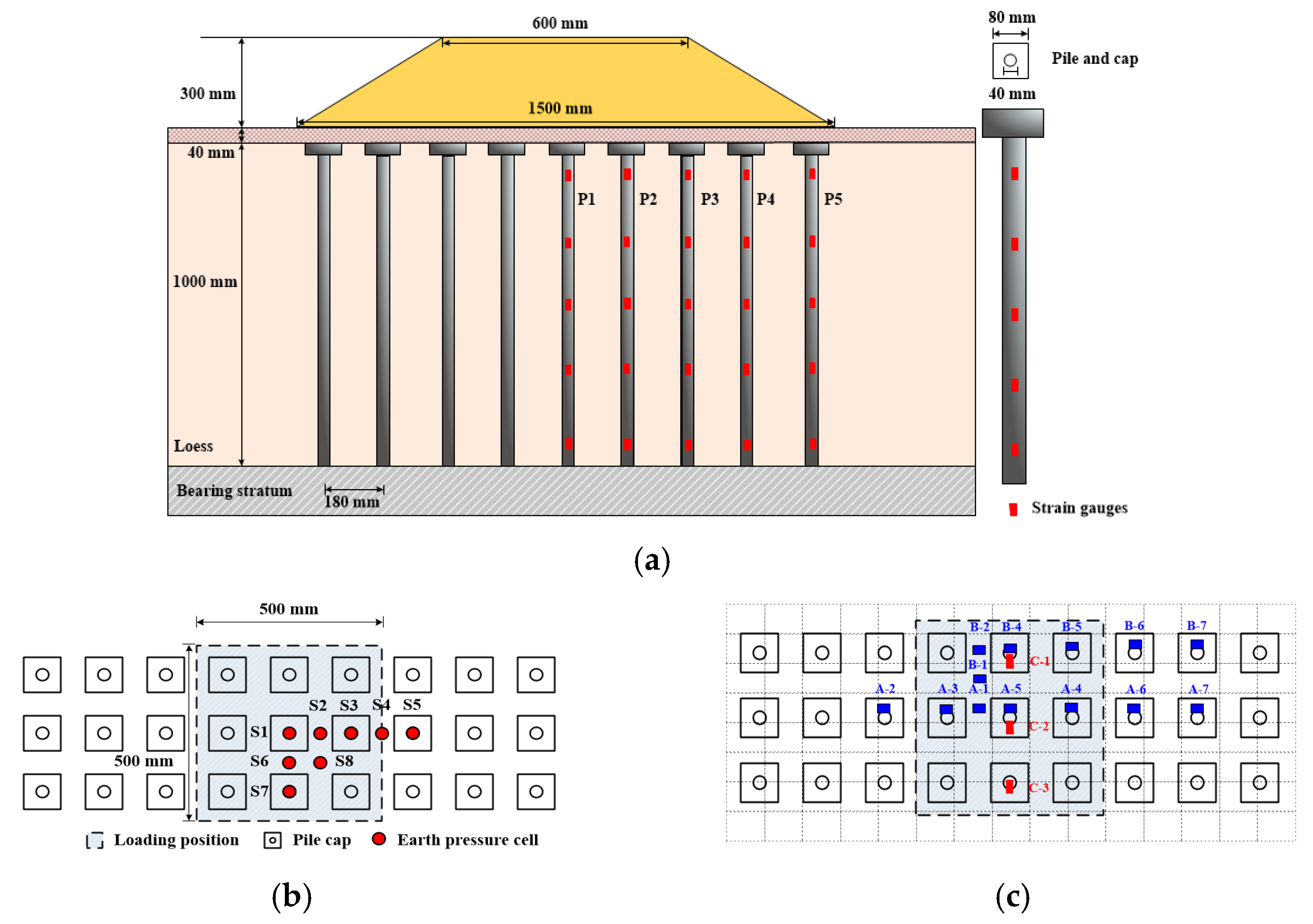
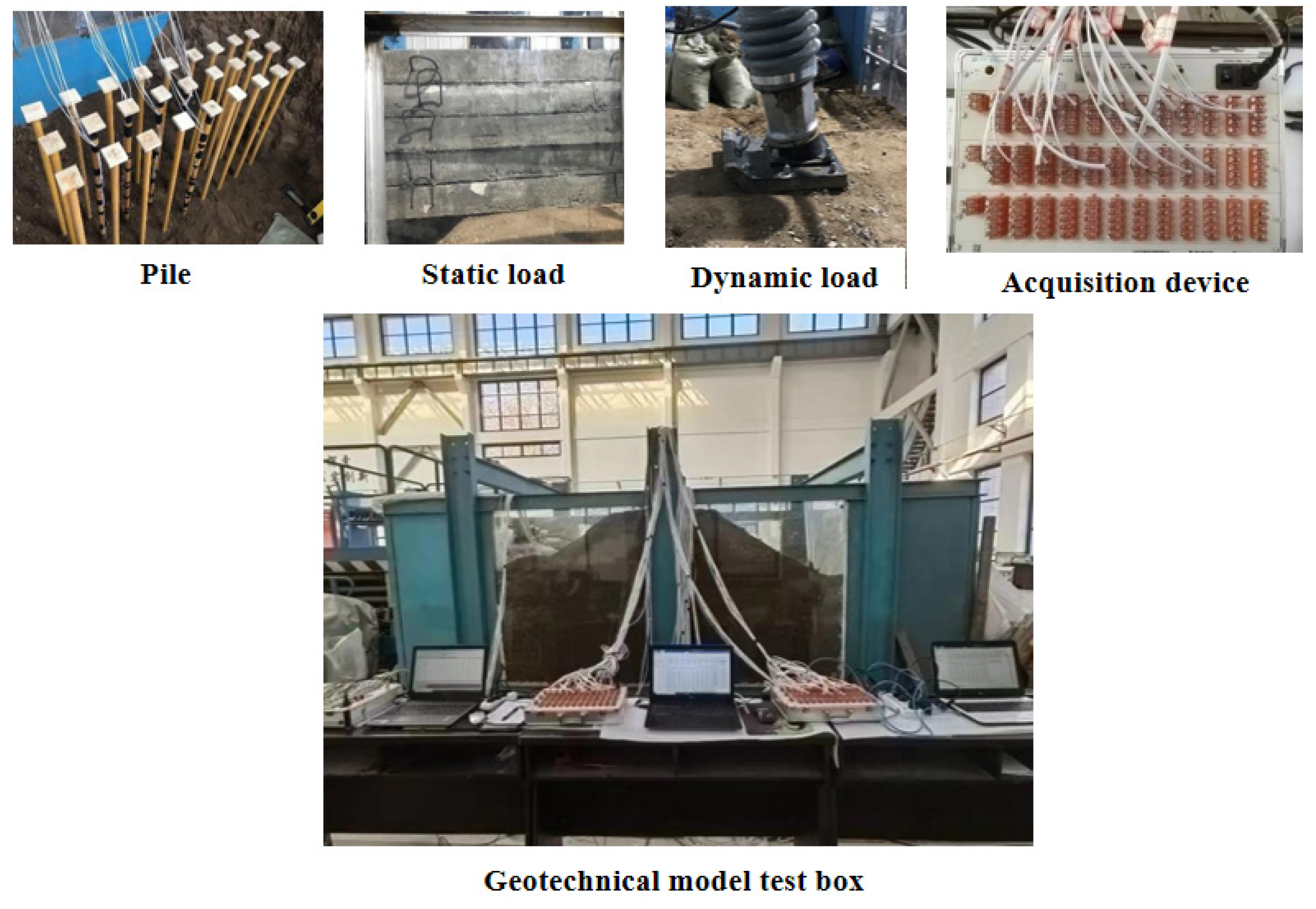

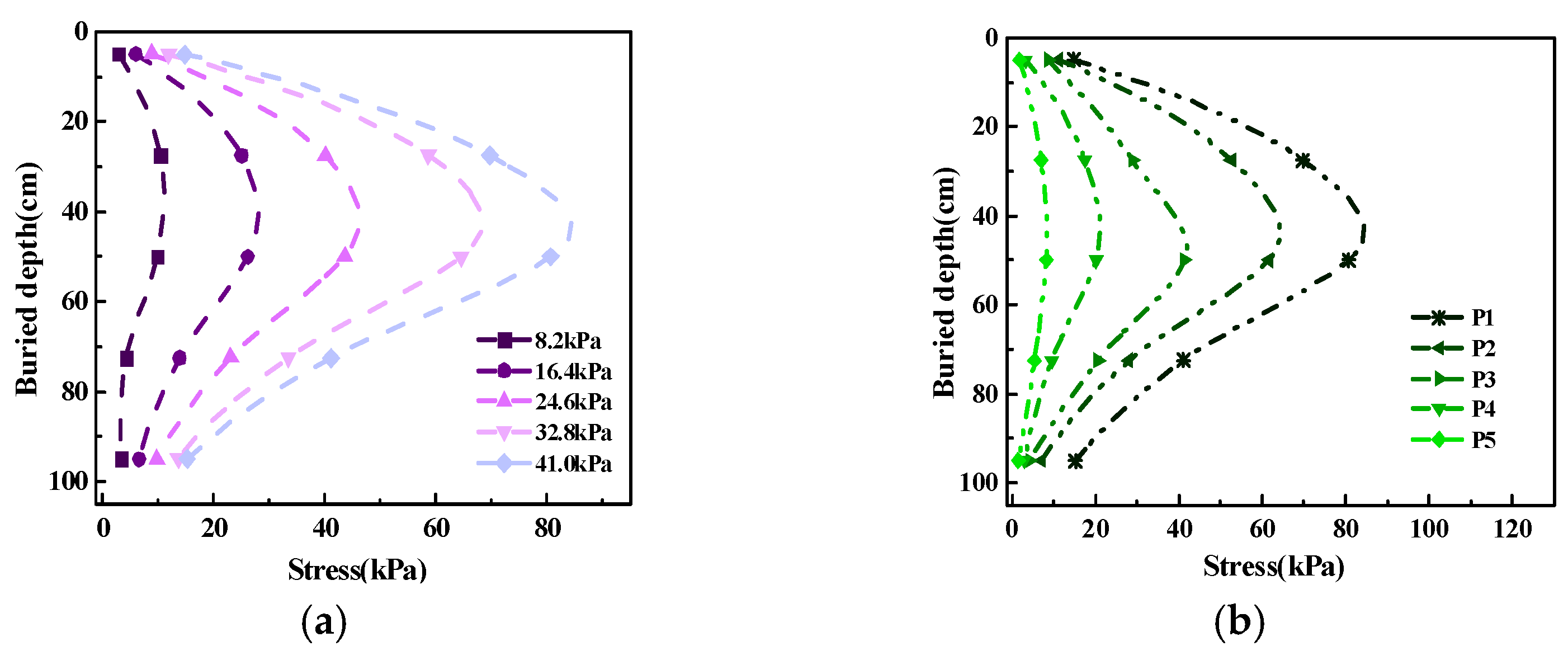
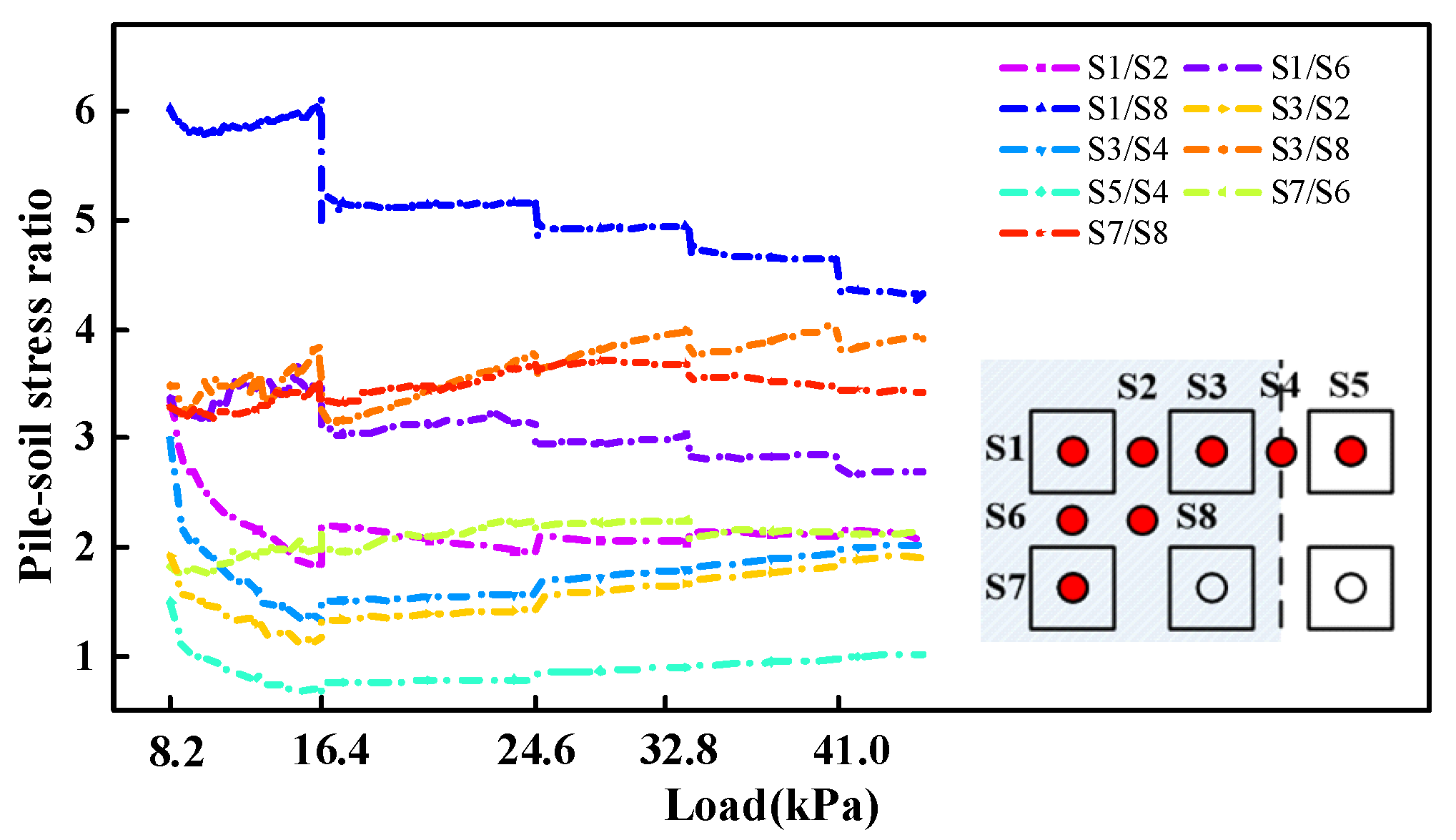


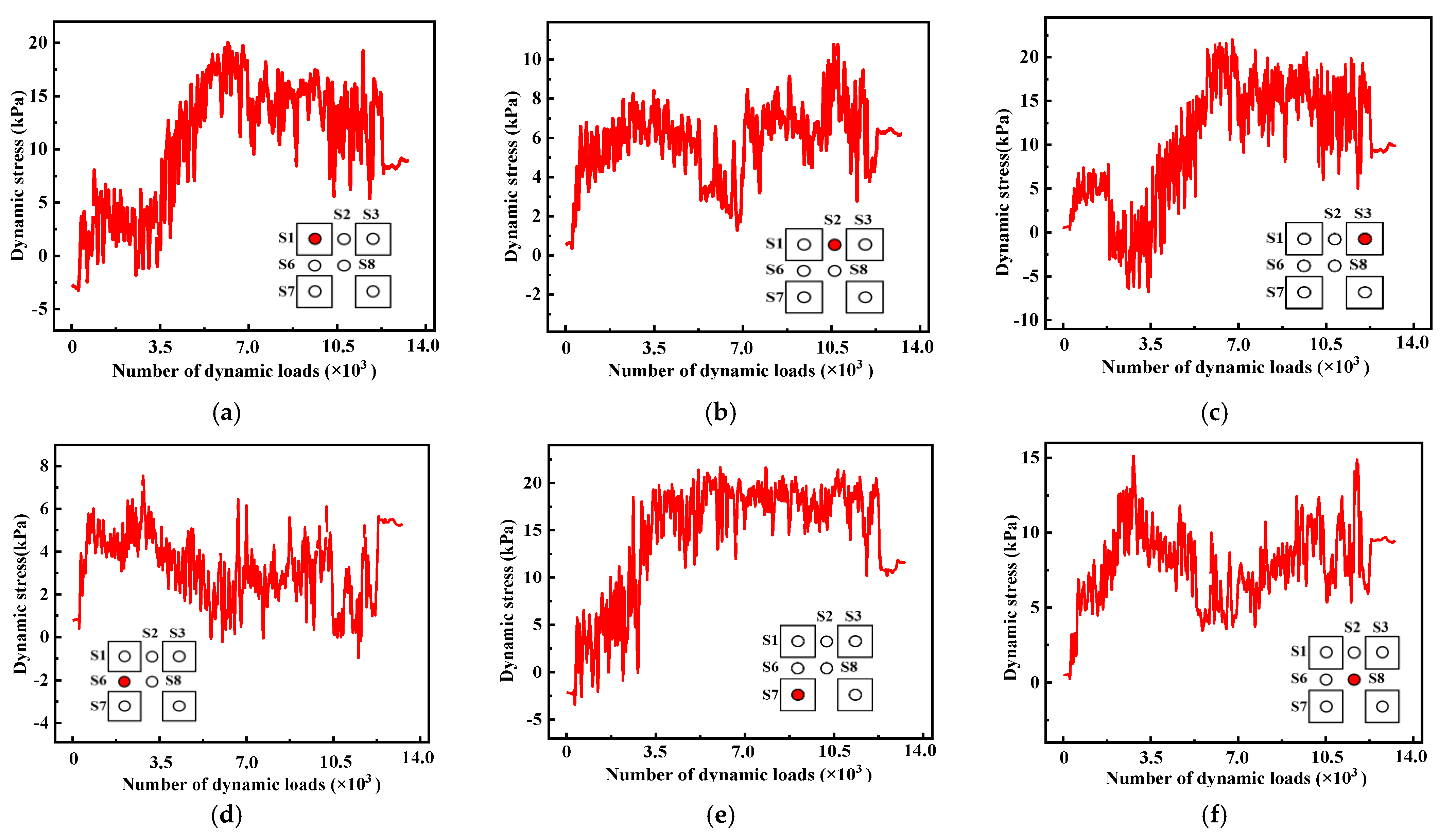
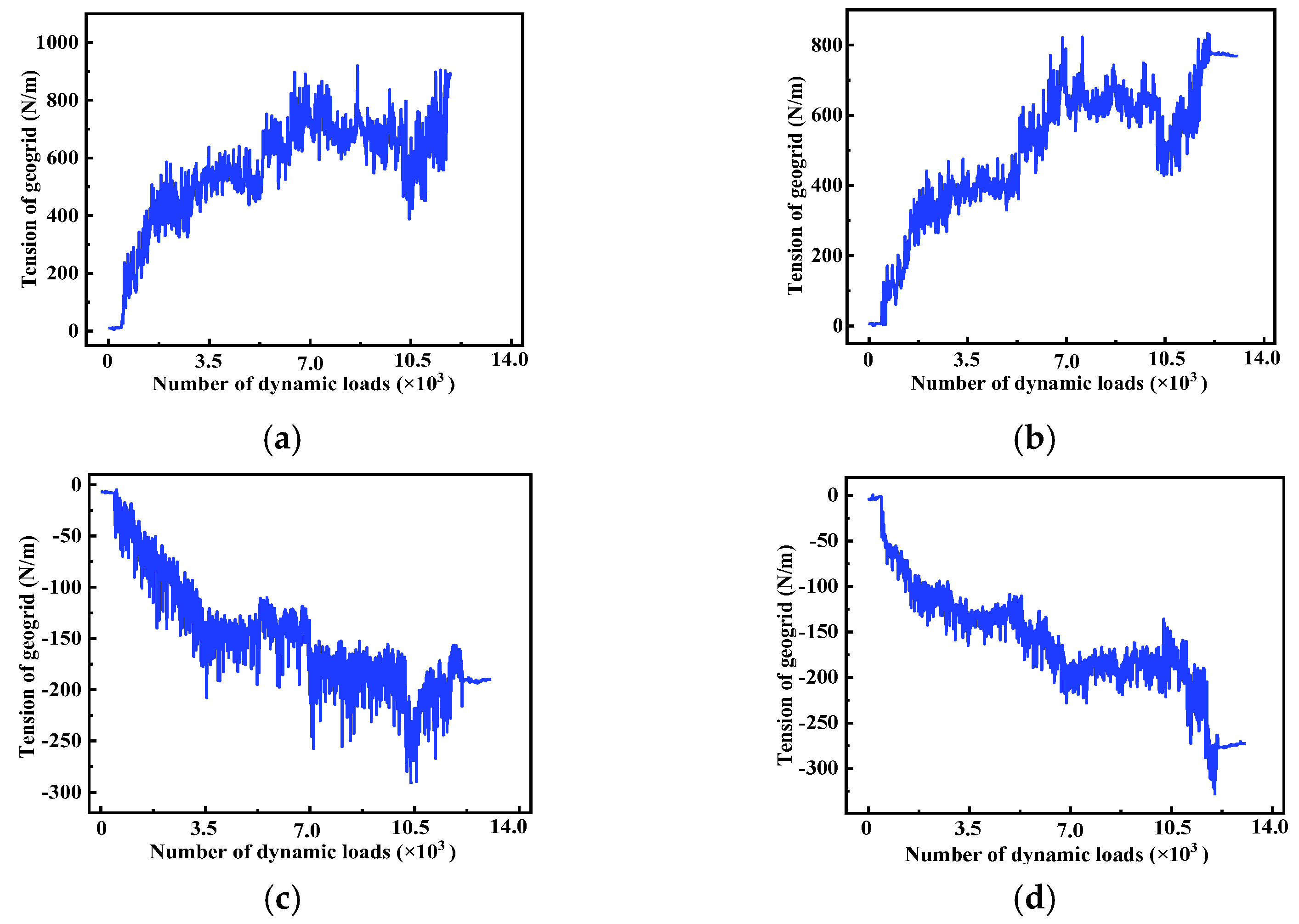
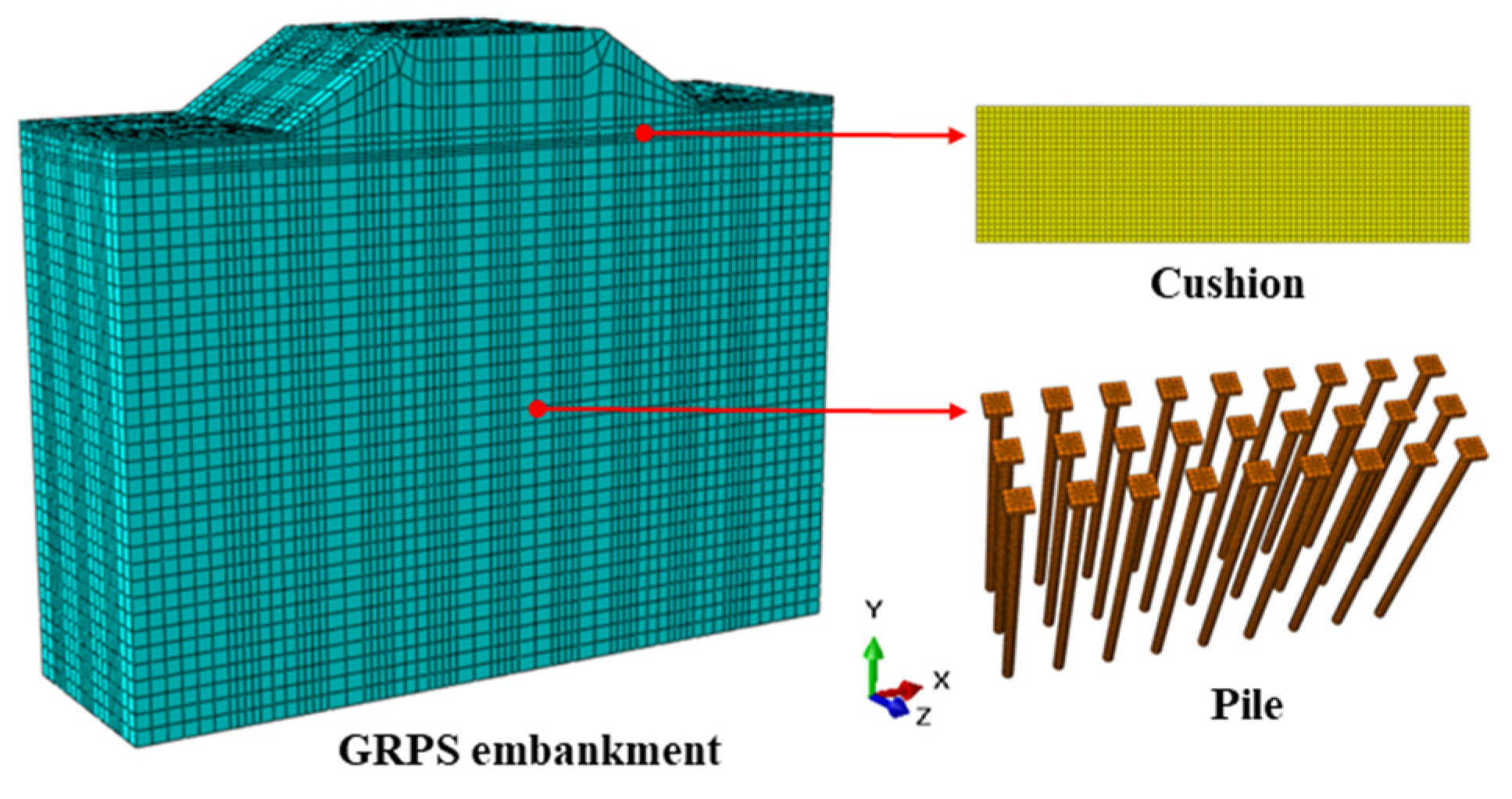
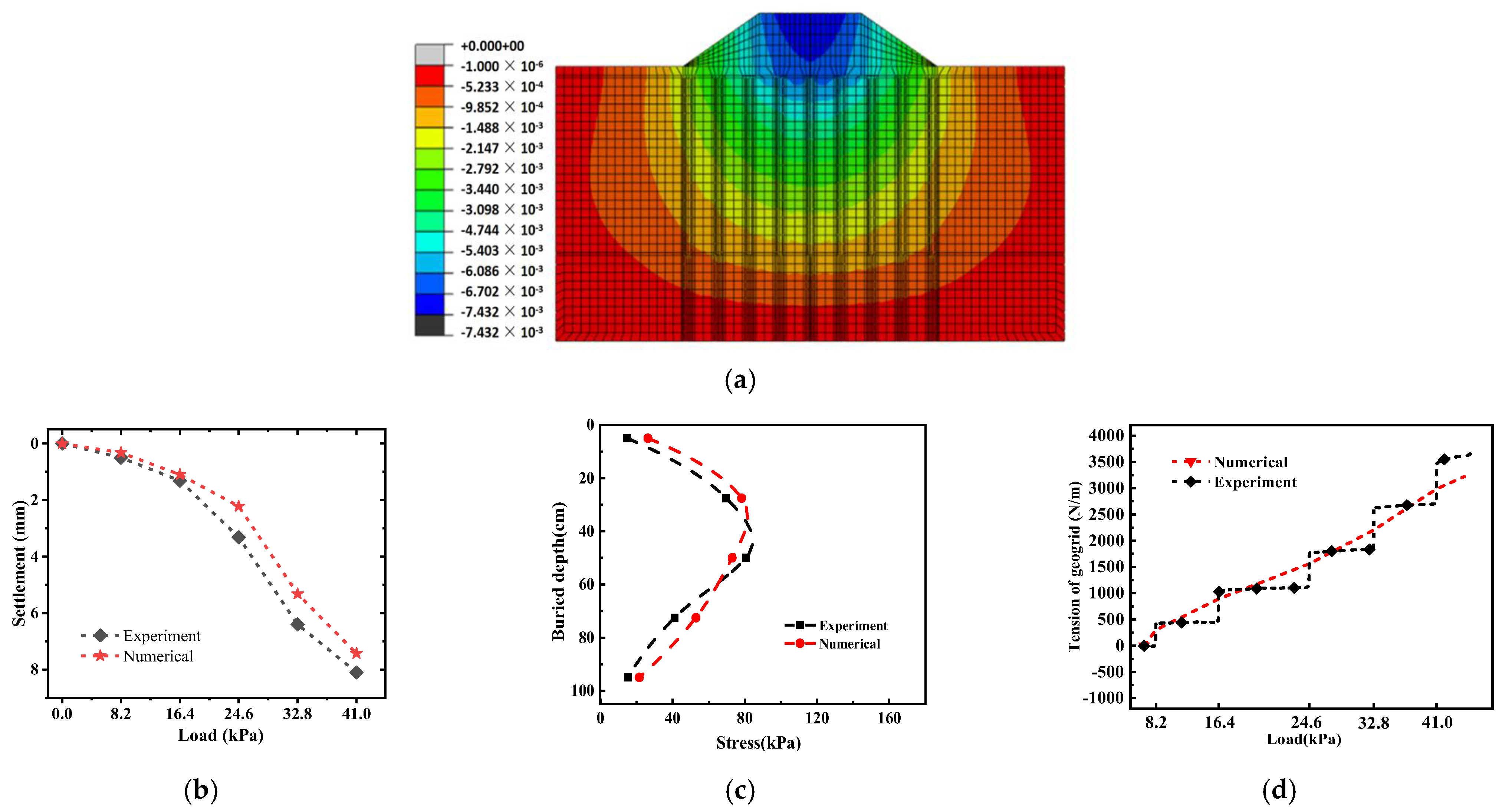
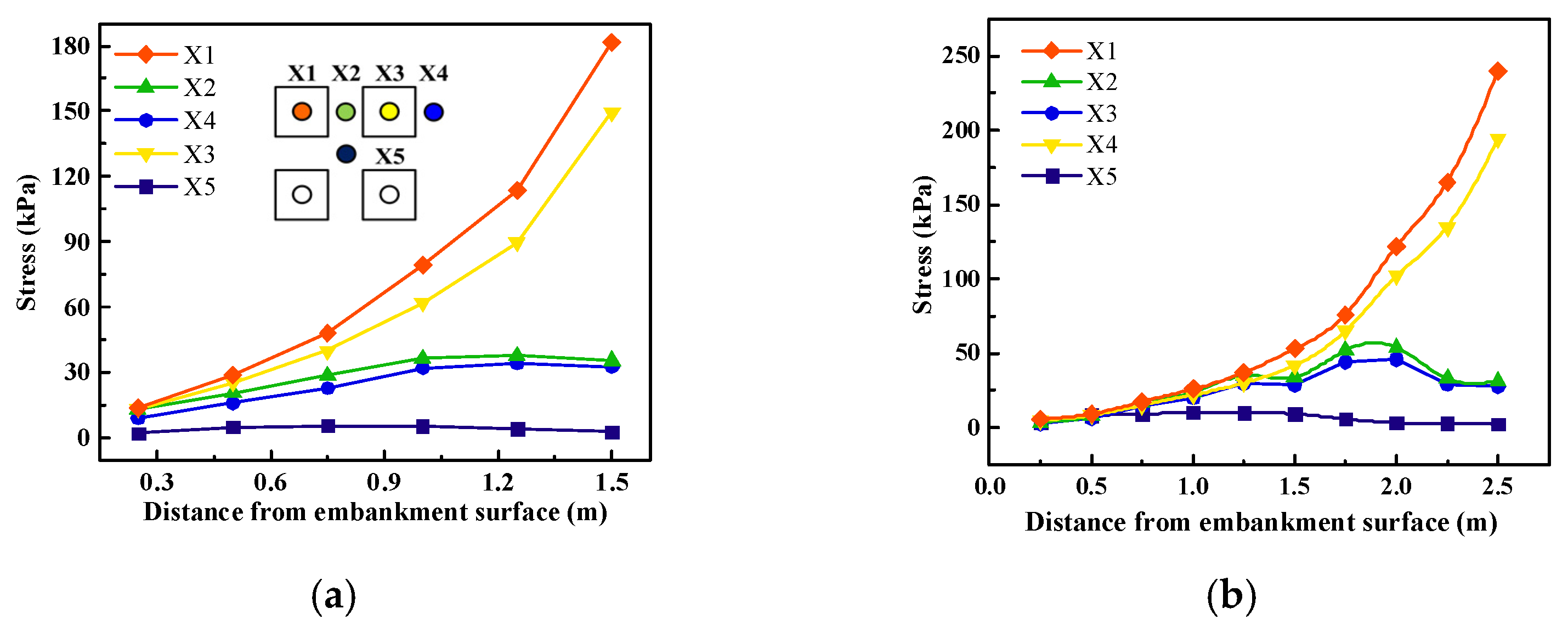
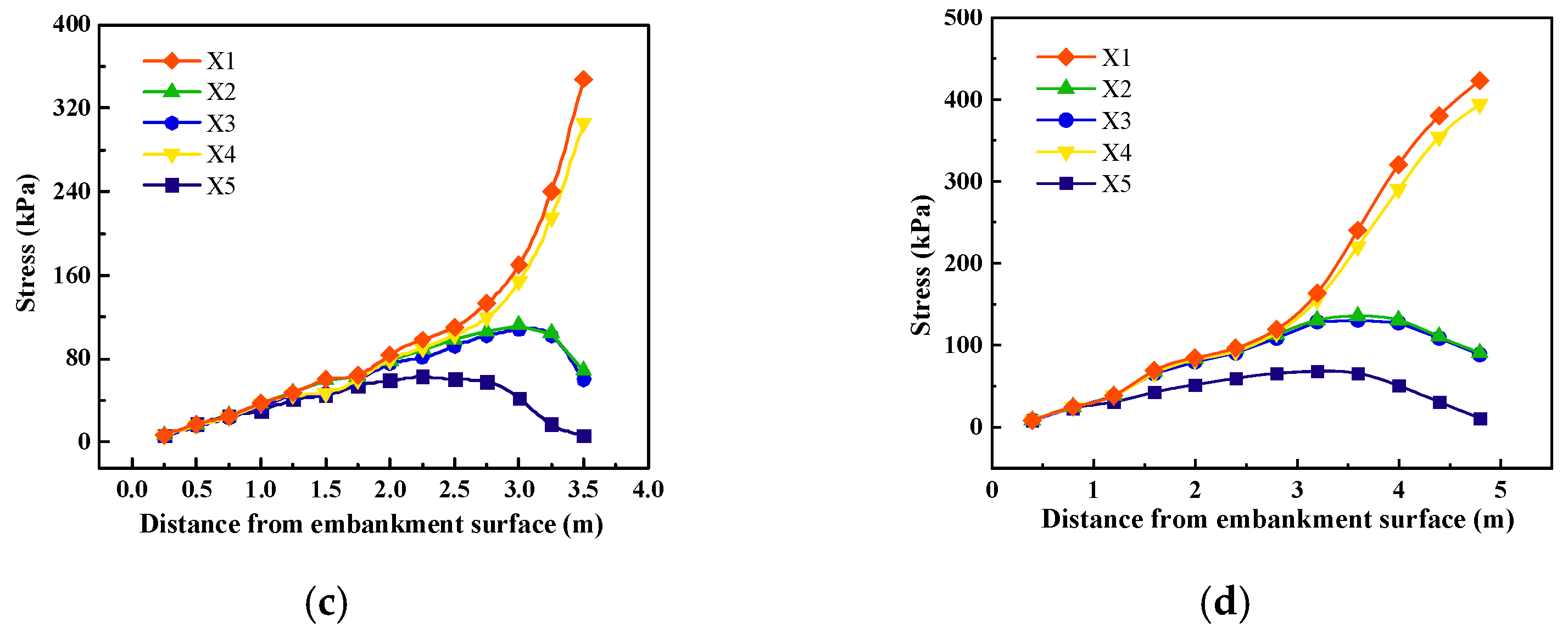
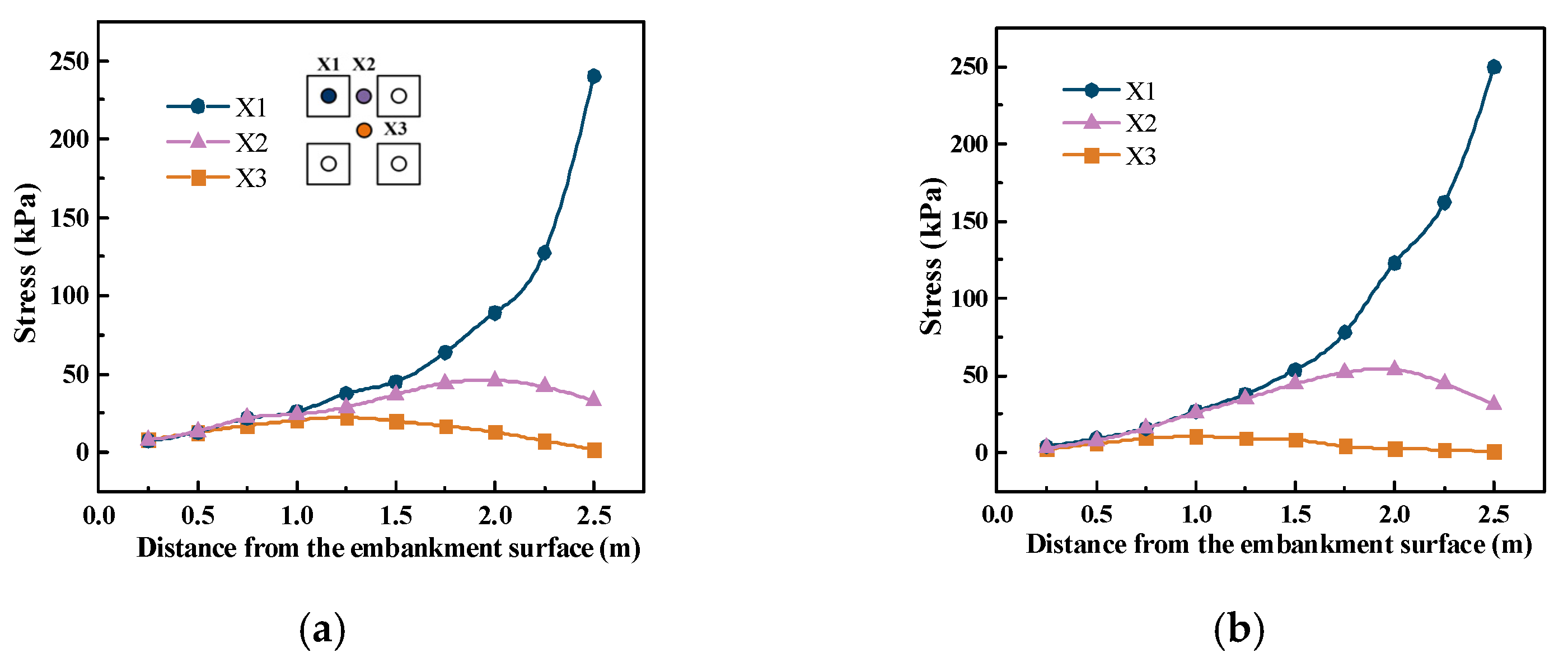


| Type | Physical Quantity | Similarity Coefficient |
|---|---|---|
| Similarity ratio | Length | |
| Elasticity modulus | ||
| Density | ||
| Unit weight | ||
| Poisson ratio | ||
| Strain | ||
| Stress | ||
| Displacement |
| Name | Unit Weight (kN/m3) | Internal Friction Angle (°) | Cohesive Forces (kPa) | Moisture Content (%) | Poisson Ratio | Elasticity Modulus (MPa) |
|---|---|---|---|---|---|---|
| Loess | 19.4 | 28.24 | 37.8 | 17.6 | 0.32 | 7.99 |
| Cushion | 25.0 | 40 | 38.5 | 16.3 | 0.14 | 65 |
| Embankment | 22.0 | 40 | 36.2 | 15.5 | 0.17 | 38 |
| Pile | 22 | - | - | - | 0.33 | 1 × 104 |
| Parameters | Unit | Values |
|---|---|---|
| Mesh size | mm | 30 |
| Longitudinal tensile strength | kN/m | 30 |
| Poisson ratio | - | 0.39 |
| Elasticity modulus | GPa | 2.32 |
| Transverse tensile strength | kN/m | 30 |
| Longitudinal tensile strength at 2% strain | kN/m | 10.5 |
| Transverse tensile strength at 2% strain | kN/m | 10.5 |
| Longitudinal yield elongation | % | 13 |
| Transverse yield elongation | % | 16 |
Disclaimer/Publisher’s Note: The statements, opinions and data contained in all publications are solely those of the individual author(s) and contributor(s) and not of MDPI and/or the editor(s). MDPI and/or the editor(s) disclaim responsibility for any injury to people or property resulting from any ideas, methods, instructions or products referred to in the content. |
© 2023 by the authors. Licensee MDPI, Basel, Switzerland. This article is an open access article distributed under the terms and conditions of the Creative Commons Attribution (CC BY) license (https://creativecommons.org/licenses/by/4.0/).
Share and Cite
Deng, Y.; Zhao, H.; Li, L.; Yao, Z.; Li, L. Research on Static and Dynamic Loading Performance of Geosynthetic Reinforced and Pile-Supported Embankment. Appl. Sci. 2023, 13, 13152. https://doi.org/10.3390/app132413152
Deng Y, Zhao H, Li L, Yao Z, Li L. Research on Static and Dynamic Loading Performance of Geosynthetic Reinforced and Pile-Supported Embankment. Applied Sciences. 2023; 13(24):13152. https://doi.org/10.3390/app132413152
Chicago/Turabian StyleDeng, Yousheng, Huiling Zhao, Lingtao Li, Zhigang Yao, and Long Li. 2023. "Research on Static and Dynamic Loading Performance of Geosynthetic Reinforced and Pile-Supported Embankment" Applied Sciences 13, no. 24: 13152. https://doi.org/10.3390/app132413152
APA StyleDeng, Y., Zhao, H., Li, L., Yao, Z., & Li, L. (2023). Research on Static and Dynamic Loading Performance of Geosynthetic Reinforced and Pile-Supported Embankment. Applied Sciences, 13(24), 13152. https://doi.org/10.3390/app132413152





